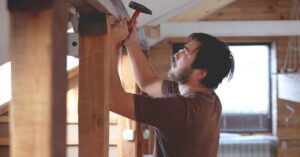The 2010s marked an all-time high for adaptive reuse projects across the U.S. commercial real estate sector — and the start of a new decade appears to be just as promising, according to a recent RentCafe study. The past two years ended with an estimated total of 32,000 units converted into apartments, with more than 20,100 dwellings — a single-year record — set to be completed in 2021.
This growing trend has no doubt caught the attention of commercial mortgage brokers and lenders across the country. These conversions can be expensive, so landlords will need commercial mortgage professionals to help fuel this ongoing movement.

Recycled buildings
The COVID-19 pandemic and its resulting travel restrictions have helped to create a wave of hotel redevelopment projects. Yet former offices continue to be the most popular properties to adapt as demand for office space dwindles and remote work becomes widespread.
It’s unclear whether the trend toward working from home will continue at anywhere near current levels once the pandemic is truly over. But for now, office space is a leading source of adaptive reuse projects, which allow for a building to be repurposed. This type of “recycling” is often a cheaper and faster alternative than building something from the ground up.
Residential conversion projects have successfully created apartments in underutilized, historic and even abandoned buildings that once served other purposes. Beyond the lower costs and shorter timelines, adaptive reuse is being recognized as an environmentally friendly development option, according to Emil E. Malizia, director of the department of city and regional planning at the University of North Carolina at Chapel Hill. This is especially true if demolition is involved, Malizia said, as adaptive reuse mitigates climate change while demolition and new construction do not.
The cities that delivered the most apartment units through adaptive reuse in the past two years were Philadelphia, Washington, D.C., Cleveland, Chicago and Los Angeles. Each of these cities converted more than 1,000 units, with Philadelphia closing in on 2,000 units. What do these cities have in common? A large number of old or underused buildings that are ripe for conversion while avoiding the wrecking ball.
Office-building lure
RentCafe estimates that of the 32,000 apartment units created through adaptive reuse since 2020, 41% of them are in former office buildings. This means that office conversions singlehandedly created some 13,000 new apartments, many of them in urban areas.
The pandemic accelerated many adaptive reuse projects that focused on offices. According to RentCafe, Washington, D.C., is the top city for office-to-apartment conversions. Of the 1,760 apartments created through adaptive reuse in the nation’s capital during the past two years, nearly 1,110 are in former office buildings, including the former U.S. Department of State headquarters during World War II. The second-highest number of apartment units created through office conversions during this time took place in Chicago, where 1,020 of the 1,135 apartments delivered through the repurposing of older buildings are in former offices.
Since 2020, the city of Alexandria, Virginia, also has focused its adaptive reuse efforts on office conversions. Remarkably, all of the 955 units delivered here were in former office buildings. Malizia said that the conversion of office space is more expensive than that of hotels, but office buildings tend to be located near urban centers, making them attractive choices.
Creative impetus
The push to create more housing has impacted many types of real estate. Before the recent rush in office-space conversions, hotels were the go-to transformative property type — for obvious reasons. The residential-friendly floor plans, existing utilities and the easy transition from reception to concierge services are some of the reasons that hotels are favored for these adaptations.
Factory-to-apartment conversions also have made their mark due to increasingly popular open-space layouts, uniquely large windows and newly gentrified locations. Since the start of 2020, 4,350 new apartment units have been created through factory conversions while 3,900 units have been born through hotel conversions. This includes a turn-of-the-century mill in North Carolina and a vintage inn in Pennsylvania.
Times continue to change, of course. It’s not only offices, hotels or factories that show immense potential for residential use. Old hospitals, retail malls and even abandoned schools are gaining in popularity. Conversion projects in recent years have been tied to a wide range of nonresidential property types, from an 1880s military hospital to a 1920s brush factory.
On the horizon
In regard to the future of adaptive reuse projects slated for completion in 2022 or later, Yardi Matrix data shows that there are 306 planned projects across the U.S. that are estimated to bring more than 52,700 apartments onto the market. These future projects include ones already under construction as well as those that are in the planning or approval stages.
Of the projects in the pipeline, about 23% are located in former office buildings, with plans to deliver more than 12,300 apartment units starting in 2022. This figure may change, however, depending on the future of remote work. But if the change in traditional office life continues, this could be the beginning of an even larger office-to-apartment movement. Besides offices, future adaptive reuse projects involve hotels and factories as well as former health care facilities, warehouses, schools, retail spaces, churches and community centers.
Los Angeles is the city with the most upcoming conversion projects. The City of Angels expects more than 4,300 new apartments to be adapted in nonresidential buildings starting this year. Next on the list are Cleveland and St. Louis, each with more than 1,600 apartments to be delivered this year and beyond.
● ● ●
Although adaptive reuse is nothing new, this movement has skyrocketed in recent years and shows no signs of slowing down. Commercial mortgage brokers and lenders need to be aware of this trend and be proactive to make the most of this form of real estate recycling.
It’s easy to understand the appeal of a process that manages to conserve development resources and historic properties at the same time. By minimizing new construction and focusing on repurposing, all parties in the real estate ecosystem — from developers and investors to brokers and lenders — have a chance to promote sustainable projects in an increasingly climate-aware society, all while boosting the much-needed apartment inventory. ●
Author
-

Alexandra Ciuntu is a creative writer and researcher for RentCafe. With a background in e-learning content writing and a passion for knowledge-sharing platforms, she has covered topics from property technology to renters insurance and interior design tips. Because she is personally familiar with the renter lifestyle, Ciuntu enjoys researching and writing about renter demographic shifts and residential real estate market trends. Her articles have been featured in several national and international online publications, including The New York Times, Barron’s, Inman, Forbes, Architectural Digest, Marketwatch, Bisnow and Curbed.
View all posts






